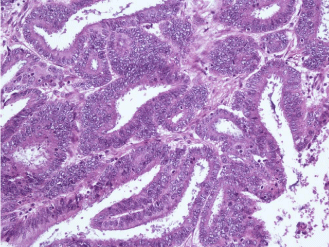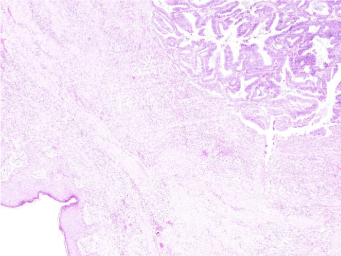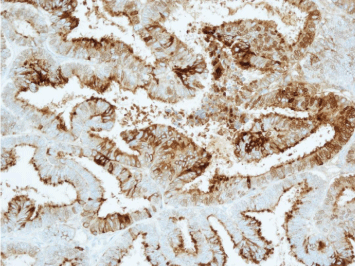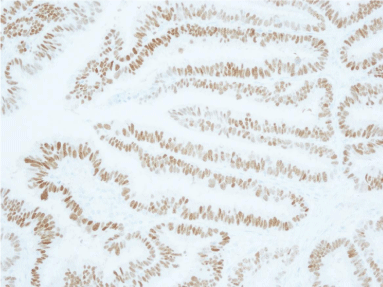
Case Report
Austin J Obstet Gynecol. 2015;2(2): 1040.
Laparotomy Wound Recurrence of Endometrioid Tumor
Paolo Croce¹, Carlo Galli¹, Silvia Zanchi¹,Donatella Perotti¹, Gianluca Raffaello Damiani¹,²*,Antonio Pellegrino², Lucia panzeri¹ and Antonella Frigoli¹
¹Department of Obstetrics and Gynecology, Azienda Ospedaliera di Lodi, Codogno Hospital, Italy
²Department of Obstetrics and Gynecology, Azienda Ospedaliera di Lecco, Alessandro Manzoni Hospital, Italy
*Corresponding author: Gianluca Raffaello Damiani, Department of Obstetrics and Gynecology, Azienda Ospedaliera di Lodi, Codogno Hospital, Italy
Received: December 22, 2014; Accepted: May 06, 2015; Published: May 12, 2015
Abstract
Endometrioid adenocarcinoma is one of the most form of common female genital cancer. Recurrences in the laparotomy wound that usually develop in the first year following surgical treatment are rare. Recurrences are more frequently associated to laparoscopic treatment and to advanced stage of malignancy. In literature there are few related works, mainly case reports. Cutaneous recurrences can be treated by surgery, radiotherapy or chemotherapy, according both to clinical conditions of the patient and the presence of other metastatic lesions in different sites. The prognosis of an isolated recurrence is generally favourable. We present a patient affected by uterine fibromatosis, who was surgically treated with hysterectomy and bilateral salpingo-oophorectomy. Three months later, the patient developed in the abdominal scar an adenocarcinoma recurrence, consistent with well differentiated endometrioid neoplasm, referable to a genital cancer. Considering the genital apparatus and supposing a cancer of tiny dimensions, the tubaric origin of the neoplasm is the most probable, due to the fact that, a minor number of sections are usually studied on the fallopian tubes rather than on the cervix and endometrium. The surgical removal of the lesion, followed by chemotherapy and radiotherapy leads to healing. The patient is actually tumor free, 80 months later.
Keywords: Endometrioid tumor; Wound recurrence; Incisional scar
Introduction
Endometrioid adenocarcinoma is the fourth most common gynaecological cancer. It is associated with favourable prognosis [1,2]. Occurrences of laparotomic wound metastases following surgical treatment are rare or just modestly described in literature. Their incidence is evaluated from 1% to 2%, similarly to the incidence of laparoscopic port-side metastases. The rate has been shown to be greater when peritoneal carcinomatosis is found during the primary surgery [3-5]. Recidives mostly occur within 12 months after surgery [6]. The prognosis is related both to the staging and to the treatment of the primary cancer; the prognosis of skin metastases is good if not associated with other localizations, [7].This report presents an atypical case of subcutaneous metastases of endometrioid adenocarcinoma. The patient underwent abdominal extrafascial hysterectomy with bilateral salpingo-oophrectomy, type A according to Queries classification [8] because of a suspected myometrial malignancy. The histological finding revealed cellular leiomyoma with cytological atypia (<10 mitosis x 10 h.p.f.).
Case Report
An 80-year-old, nulliparous, caucasian woman with hypertensive and dyslipidemic disorders underwent a gynaecological examination for abdominal pain associated to irregular bleeding. Her BMI was 28, 1. She reached a physiological menopause in her mid-fifties. The vagina appeared atrophic so the vaginal stenosis did not allow the digital exploration. Completing the pelvic bimanual exam by rectal examination, the uterus was revealed fibromatous and increased in volume. An ultrasound evaluation showed a leiomyoma on the bottom of the uterus of 72 x 71 x 70 mm, and a second infralegamentary myoma on the left of the uterus of 50 x 41 x 55 mm. Both appeared grown by about 20% in dimension during the previous three months. Endometrium was dishomogenous but linear, its maximal thickness measured 6 mm. Pap test, mammography, kidney ultrasound evaluation and the thorax radiography were negative. Hysteroscopic finding was atrophic endometrium, but it was evidenced a severe Asherman syndrome, which hindered an accurate intrauterine study. Suspecting a myometrial cancer, the patient underwent extrafascial hysterectomy with bilateral salpingo-oophrectomy, type a [8]. An abdominal incision was performed according to Kustner’s procedure. No complications occurred during the hospitalization and the patient was discharged 4 days after surgery. The histological examination revealed cellular leiomyoma with cytological atypia (<10 mitosis x 10 h.p.f.) without necrotic areas, cystic endometrial atrophy, ovarian atrophy and chronic salpingitis. Two months later, the patient discovered a painful nodule on the right end of the laparotomic scar port, of about 20 mm diameter. The clinician explained the lesion as a foreign body inflammatory reaction. Because of the nodule’s growing dimension, the patient was referred to our hospital. Six months after the first surgical treatment, an excisional biopsy of the subcutaneous neoformation, measuring 30 mm diameter, was performed.
The histological finding confirmed a subcutaneous localization of well differentiated adenocarcinoma with a cystic papillary structure, endometrioid aspects and moderate mucosecretion. Neither epidermal involvement nor vascular invasion were noticed. Immunohistochemical profile was: CA 125 +; Ck 7 ++; Ck 20 negative; oestrogen ++; progesterone ++; EMA + (Figure 1-5). This result appeared compatible with a genital cancer, with a possible occult primary malignancy. The following abdominal CT scan detected pelvic peritoneal nodes of uncertain meaning. There was no evidence of thoracic lesion at the radiography. The colonoscopy did not identify any neoplastic lesion. The mammography was negative. The PET scan performed one month later discovered a remaining subcutaneous nodule, measuring 10 x 13 mm in diameter, located under the scar of the biopsy, on the right, over the bladder. The patient received external radiation therapy focused on the area of the lesion, (54 Gy – telecobalt-therapy). Moreover, in order to improve the radio sensitivity of the area, chemotherapy with four weekly cycles of cisplatin (40 mg/m²) was concomitantly performed. After 1 month CA 125 and Ca 19.9 were respectively 36, 6 IU7ml and 9, 2 IU/ ml. PET scan supported a clear reduction in dimension of the nodule. The following examinations did not evidence any recurrence of the pathology. After Six years the patient is tumor free.

Figure 1: Immunohistochemical image of subcutaneous metastasis (200x).

Figure 2: Immunohistochemical image of subcutaneous metastasis (200x).

Figure 3: Immunohistochemical profile was: Ck 7 ++.

Figure 4: Immunohistochemical profile: oestrogen ++.

Figure 5: Immunohistochemical profile: CA 125 +.
Discussion
The physiopathology of port-site metastases is not clearly known. Different factors can take part in the development of these lesions around the wound: an advanced tumor, a positive peritoneal washing, a lymphatic or vascular diffusion are cause of multiple metastases on the wound and other concomitant recurrences. When there has been an excessive manipulation of the primary neoplasia during surgery with the consequent direct implantation of atypical cells, the recurrence is only on the wound. In these cases the tumor growth may be slow due to poor vascularization of the scar tissue [9]. In literature there is not agreement in data about the major risk of port-sites metastasis on laparoscopic versus laparotomic incision [10,11]. Nevertheless, the correct surgery technique associated to repeated washing of the involved area, the adequate protection of the abdominal wall, the peritoneal suture and the minimal handling of the tumor seem to reduce the danger of cutaneous metastasis to less than 1%, both in laparotomic and in laparoscopic surgery [4]. In more than half cases reported, the neoplasia presents an advanced stage at the first surgical treatment. However different case reports describe cutaneous metastasis after the treatment realised at first or second FIGO stage cancer [4-12].Usually the cutaneous recurrences mature within the first twelve months [6]; but lesions grown five [13] and even fourteen years later [14] are known. Treatment depends on the clinical conditions of the patient, the number of recurrences and their locations. It can be composed of surgery, radiotherapy and chemotherapy. If there is only an isolated recurrence, the prognosis is favourable [15]. Our case report distances itself from other cases reported in literature because any diagnosis of endometrioid cancer did not follow the first surgical treatment. Only in retrospect the diagnosis of occult endometrioid primary carcinoma was formulated, consistent with a plausible genital origin of the cancer. Considering the genital apparatus and supposing a cancer of tiny dimensions, the tubaric origin of the neoplasm is the most likely. Indeed a minor number of sections are usually studied on the fallopian tubes rather than on the cervix and on the endometrium, except for cases in which there is a clear diagnostic suspect of malignancy on tubes. The surgical treatment followed by the radio-chemotherapy has been able to keep the patient cancer free six years after the metastases removal.
Conclusion
In literature it is clearly reported that if the original endometrioid adenocarcinoma is at advanced stage, port-side metastasis after both laparotomic and laparoscopic surgery are not rare [16]. On the contrary, at the beginning stages of the tumor (like FIGO IA and IB) cutaneous metastasis located in scars incision are rare, even if the eventuality must be kept in consideration. The appearance of a painful and quickly-growing nodule in the proximity of the surgical scar should make clinicians suspicious, leading them to the histological diagnosis. The anamnesis and the clinical aspect in the first year after the surgical treatment are important features for a correct diagnostic procedure and an efficient therapy. Infrequently, cutaneous recurrences develop several years later. Our case-report, demonstrates that, if the malignancy is circumscribed, the planning of an adequate therapy allows the prognosis to become favourable.
References
- Jemal A, Siegel R, Xu J, Ward E. Cancer Statistics, 2010. CA Cancer J Clin. 2010; 60: 277-300.
- Jemal A, Bray F, Center MM, Ferlay J, Ward E, Forman D. Global Cancer Statistics. CA Cancer J Clin. 2011; 61:69-90.
- Ramirez PT, Frumovitz M, Wolf JK, Levenback C. Laparoscopic port-site metastasis in patients with gynecological malignancies. Int J Gynecol Cancer. 2004; 14: 1070-1077.
- Martinez A, Querleu D, Leblanc E, Narducci F, Ferron G. Low incidence of port-site metastasis after laparoscopic staging of uterine cancer. Gynecologic Oncology. 2010; 118: 145-150.
- Palomba S, Falbo A, Russo T, La Sala GB. Port-site metastasis after laparoscopici surgical staging of endometrial cancer: A systematic review of the published and unpublished data. J minim invasive gynecol. 2012 ; 19: 531-537.
- Jereczek-Fossa B, Badzio A, Jassem J. Recurrent endometrial cancer after surgery alone: results of salvage radiotherapy. Int J Radiot Oncol Biol Phys. 2000; 48: 405-413.
- Daniilidis A, Pantelis A, Lathouras K, Papathanasiou O, Loufopoulos A, Vrachnis N et al. A rare case of umbilical and vaginal metastasis from endometrial cancer-review of the literature. Eur J Gynaecol Oncol. 2012; 33: 436-437.
- Querleu D, Morrow CP. Classification of radical hysterectomy. Lancet Oncol. 2008; 9: 297-303.
- Macias V, Baiotto B, Pardo J, Muñoz F, Gabriele P. Laparotomy wound recurrence of endometrial carcinoma. Gynecol Oncol. 2003; 91: 429-434.
- Ramshaw BJ. Laparoscopic urgry for cancer patients. CA Cancer J Clin. 1997; 47: 327-350.
- Allardyce RA. Is the port site really at risk? Biology, mechanisms and prevention: a critical view. Aust NZJ Surg. 1999; 69: 479-485.
- Sanjuán A1, Hernández S, Pahisa J, Ayuso JR, Torné A, Martínez Román S et al. Port-site metastasis after laparoscopic surgery for endometrial carcinoma: two case reports. Gynecologic Oncology. 2005; 96: 539-542.
- Kotwall CA, Kirkbride P, Zerafa AE, Murray D. Endometrial cancer and abdominal wound recurrence. Gynecol Oncol. 1994; 53: 357-360.
- Lorenz U, Gassel AM, Thiede A HJ. Gassel. Endometrial carcinoma recurrence in an abdominal scar 14 years after total hysterectomy. Gynecol Oncol. 2004; 95: 393-395.
- Joshi SC, Sharma DN, Khurana N, Mohanta PK, Bahadur AK. Endometrial carcinoma with recurrence in the incisional scar: A case report. Int J Gynecol Cancer. 2003; 13: 901-903.
- Zivanovic O, Sonoda Y, Diaz JP, Levine DA, Brown CL, Chi DS et al. The rate of port-site metastases after 2251 laparoscopic procedures in women with underlying malignant disease. Gynecologic Oncology. 2008; 111: 431-437.